Extension Researcher Helps Growers With Pest Problems
go.ncsu.edu/readext?925510
en Español / em Português
El inglés es el idioma de control de esta página. En la medida en que haya algún conflicto entre la traducción al inglés y la traducción, el inglés prevalece.
Al hacer clic en el enlace de traducción se activa un servicio de traducción gratuito para convertir la página al español. Al igual que con cualquier traducción por Internet, la conversión no es sensible al contexto y puede que no traduzca el texto en su significado original. NC State Extension no garantiza la exactitud del texto traducido. Por favor, tenga en cuenta que algunas aplicaciones y/o servicios pueden no funcionar como se espera cuando se traducen.
Português
Inglês é o idioma de controle desta página. Na medida que haja algum conflito entre o texto original em Inglês e a tradução, o Inglês prevalece.
Ao clicar no link de tradução, um serviço gratuito de tradução será ativado para converter a página para o Português. Como em qualquer tradução pela internet, a conversão não é sensivel ao contexto e pode não ocorrer a tradução para o significado orginal. O serviço de Extensão da Carolina do Norte (NC State Extension) não garante a exatidão do texto traduzido. Por favor, observe que algumas funções ou serviços podem não funcionar como esperado após a tradução.
English
English is the controlling language of this page. To the extent there is any conflict between the English text and the translation, English controls.
Clicking on the translation link activates a free translation service to convert the page to Spanish. As with any Internet translation, the conversion is not context-sensitive and may not translate the text to its original meaning. NC State Extension does not guarantee the accuracy of the translated text. Please note that some applications and/or services may not function as expected when translated.
Collapse ▲Jim Walgenbach, NC State Extension specialist in entomology, has a simple quest: make sure crops grown by North Carolina farmers are consumed by people, not insects.
Simple in concept, difficult in execution. Trying to mitigate perilous pests is a little like playing whack-a-mole. Smite one thing, and something else pops up.
“It keeps things interesting,” Walgenbach said. “There’s always something to work on. Insects always seem to stay one step ahead of you by developing resistance, expanding their range, or something else. Successes are temporary, because insects are always evolving. It keeps us entomologists in business.”
Walgenbach has been fighting battles as an NC State Extension pest management expert for 36 years, all spent working on fruit and vegetable crops at the Mountain Horticultural Crops Research and Extension Center in western North Carolina.
“Applied research is part of the Extension responsibility, to address the needs of growers,” he said. “I work with individual growers and groups of growers, encouraging them to try modern pest management approaches. Overall, our goal is to develop programs that allow growers to remain economically viable, and at the same time minimize risks to farm workers and the environment.”
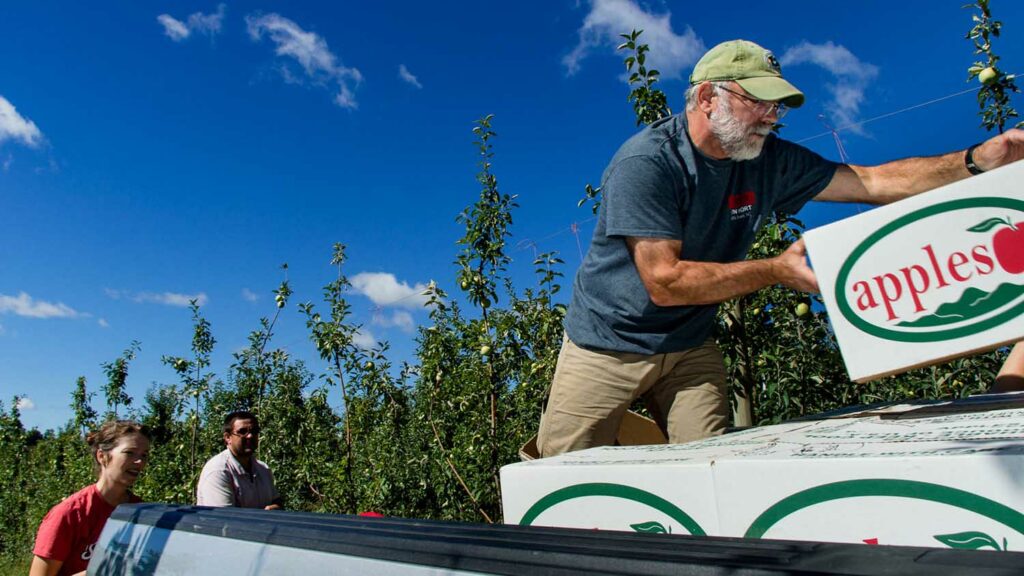
NC State Extension entomologist Jim Walgenbach’s work at the Mountain Horticultural Crops Research and Extension Center in western North Carolina helps protect the state’s apple crop.
The work done by NC State Extension entomologists to keep pests from causing significant damage to crops not only helps North Carolina growers stay in business, but ultimately benefits consumers. Protecting crops can keep prices stable at farmers markets and grocery stores.
Walgenbach is constantly researching new pest control methods and equipping growers to make informed decisions through educational programs, on-farm tests and cooperation with other Extension experts and agents and the crop protection industry.
“It’s a wide group of people that are after the proper information,” he said. “That includes the crop protection industry, because they have a big influence over what growers are doing. You want to make sure you are educating and serving as a resource for county Extension agents. They are the ones who are on the frontlines, dealing with growers on a day-to-day basis. Communicating with those people and providing the latest and most modern approaches to handling pest populations in a sustainable manner is very important.”
His research program includes insect population dynamics, insecticide resistance management, use of semiochemicals, and biological control. They are different methods and strategies for what falls under the general umbrella of integrated pest management.
“What pressing problems are the industries I serve having right now? I wouldn’t be working on thrips unless growers were experiencing problems,” he said. “That’s usually the driving force.”
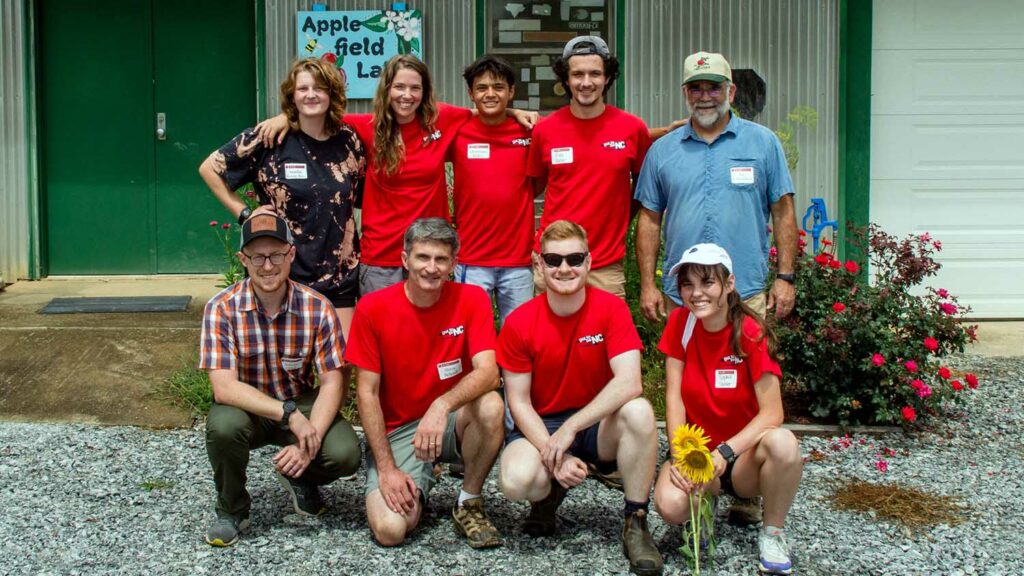
NC State Extension entomologist Jim Walgenbach’s team includes research specialist Steve Schoof, postdoctoral researchers, research assistants, graduate students and undergraduate summer assistants.
Thrips are tiny sucking insects that dine on an assortment of plants, not only causing damage to field crops, greenhouse floricultural crops and home gardens but also potentially transmitting viruses such as tomato spotted wilt virus.
“We have a project working on western flower thrips, primarily on tomatoes, which has become a serious issue in the past few years,” Walgenbach said. “They have developed resistance to insecticides, so we are investigating alternative approaches.”
Homegrown: How to Manage Pests in Home Gardens
Other projects address the brown marmorated stink bug and ambrosia beetles, insects impacting apples, one of the most important crops in western North Carolina.
“We have experienced problems with brown marmorated stink bugs on apples and peaches,” Walgenbach said. “We’ve done a lot of work to better understand its biology and ecology and we are trying some different management approaches. Ambrosia beetles are very small beetles and are associated with a complex called rapid apple decline, where trees that are seemingly healthy die in a matter of a couple of months or so.”
The roots of his scholarly work can be traced to a child-like wonder of an early form of insect management when he was growing up in rural Wisconsin.
“My father was the field man for a vegetable canning factory, managing the crops and testing to see when they were ready for harvest,” he said. “They’d bring in a guy from Milwaukee to fly his biplane to spray all the crops. My dad would get up early to load the plane with pesticide and tell him what to spray. As young as 4 or 5 years old, I’d go along and my favorite thing was to just watch them work. So I was exposed to agriculture and agricultural research from a young age. I’ve always liked the idea of managing pest populations in crops. I guess it’s kind of a weird thing. It’s in your blood. I’ve got two older brothers who are also entomologists, as well as my wife.”
There are still some areas of the country and state where highly trained ag pilots skim precision aircraft just above the ground to apply liquid herbicides, insecticides, fungicides and fertilizers, but entomological researchers like Walgenbach take a ground-based approach.
The crop dusters of his youth likely applied broad spectrum insecticides. Today, any insecticide employed in the battle against bugs is more likely to be targeted at a specific pest.
“Broad spectrums kill everything including natural enemies and it often creates secondary pest problems such as mites, aphids and thrips. Then you have to apply additional pesticides, and your overall insecticide use goes up,” Walgenbach said. “Today there are many soft chemistry options, insecticides that are very narrow spectrum in activity so they are safe to the insect’s natural enemies and have a very small environmental footprint. We have done work to develop models to enable growers to precisely time applications.”
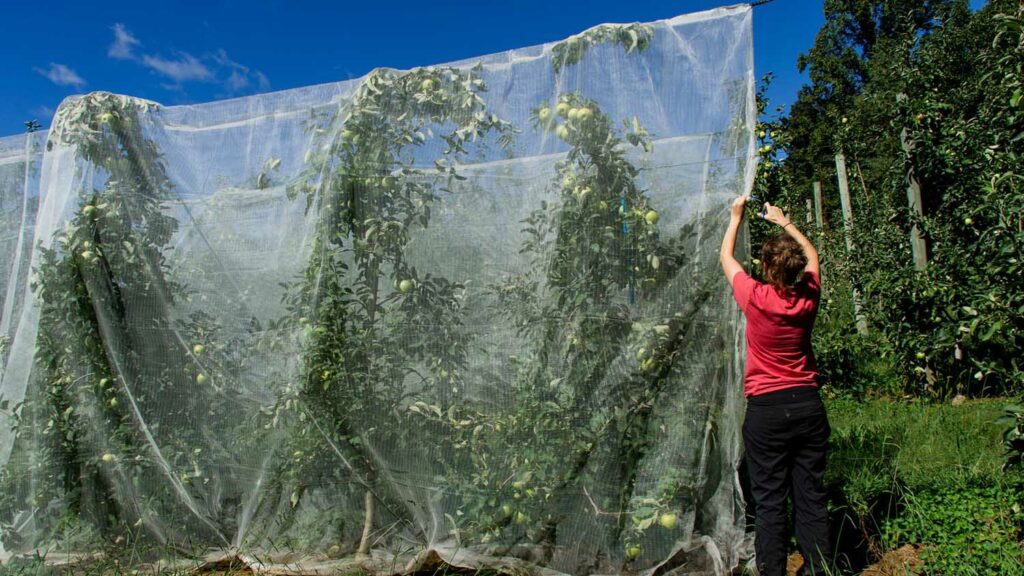
Drape netting is a barrier again insect infestation.
Research done by Walgenbach and the many associates working with him over the years has helped to more judiciously use insecticides in fruit and vegetable production, because of improved efficacy and ecological concerns.
“We’re always trying to reduce unnecessary pesticide use and develop alternative strategies to reduce the footprint of pest management,” Walgenbach said. “A good example is an insect called a codling moth, which on a worldwide basis is one of the most serious pests affecting apples.”
Over time, the codling moth developed resistance to insecticides. A different approach was required.
“We worked with growers and the industry to implement pheromone mediated mating disruption,” he said. “The female moth emits a pheromone that attracts male moths. When dispensers of synthetic versions of that pheromone are placed throughout the orchard, it reduces the frequency of mating. It has worked very well.”
Another method of insecticide-free pest management is biological control, which in non-scientific terms is basically siccing something that won’t harm crops on a bug that does. That includes predators (beneficial insects that eat a pest or its eggs) and parasitoids (insects that lay their offspring in, on, or near a host pest or its eggs, resulting in the offspring developing and feeding on the pest).
“We’ve had good success with biological control of twospotted spider mite, particularly in tomatoes, with a specialized predator called phytoseiulus persimilis, which is a small mite that can do a very good job,” he said. “That’s been a good one to work on.”
Biological control also offers perhaps the most promise in dealing with the brown marmorated stink bug, a destructive pest of concern to apple growers in the North Carolina mountains. It is an invasive insect accidentally introduced from Asia into Pennsylvania in the 1990s. It was first detected in North Carolina in 2009 in Forsyth County, and it has since spread rapidly throughout the Piedmont and mountain regions of the state.
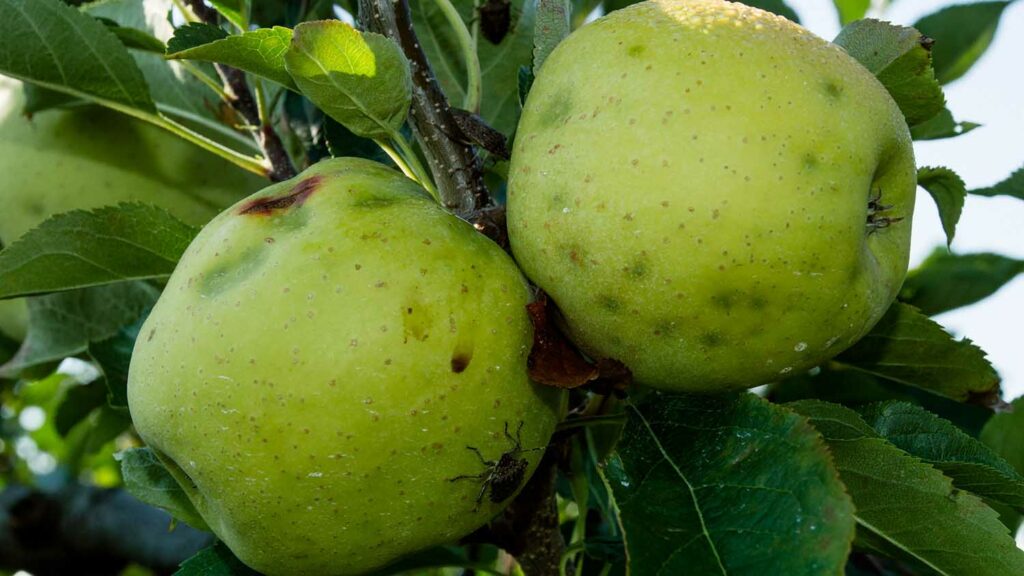
Brown marmorated stink bugs damage apple crops in western North Carolina.
While the stink bug made the journey across the seas, its natural enemies did not. It has proliferated, and proved a challenge for researchers, Extension agents and growers. Broad-spectrum insecticides have reduced the severity of damage in many crops, but they have also increased production costs and resulted in secondary pest outbreaks.
Extension researchers believe biological control holds the most promise. There has been some success with parasitoids and predators native to North Carolina, but the best results will likely come with its natural enemies that have evolved with the stink bug in its native Asian range.
“We’ve been doing some work with a native natural enemy, an Asian egg parasitoid called Trissolcus japonicus, or the samurai wasp,” Walgenbach said.
The samurai wasp is a tiny parasitic wasp that can destroy large numbers of BMSB eggs. Releasing it into areas with high BMSB populations might be the best way to bring the pest under control, but more studies are needed.
“Classical biological control is essentially going to the native area of the pest and finding their natural enemies and then releasing them here, but considerable risk assessment is necessary before that can be done,” Walgenbach said. “That involves looking at non-target effects. How is it going to affect native stink bugs, including predatory stink bugs? There are some good non-target native stink bugs; you don’t want to upset that system.”
A strain of Trissolcus japonicus has made its way to the U.S., first appearing in Delaware and slowly migrating south.
“APHIS [the USDA’s animal and plant health inspection service] does not allow transport of the insect into states where it has not yet been detected in the wild,” he said. “We monitored for the wasp in North Carolina so that when it naturally spread here we could begin redistributing it in areas of high pest pressure. Last summer we detected it for the first time, so now we’re able to begin that work.”
Other tactics investigated for the brown marmorated stink bug include a behavioral approach known as attract and kill, and physical exclusion. The former uses the stink bug’s pheromone to attract and congregate the insects to an area where they are exposed to an insecticide-impregnated netting material. The latter consists of using drape netting hung over a tree as a barrier to keep the insect from getting in.
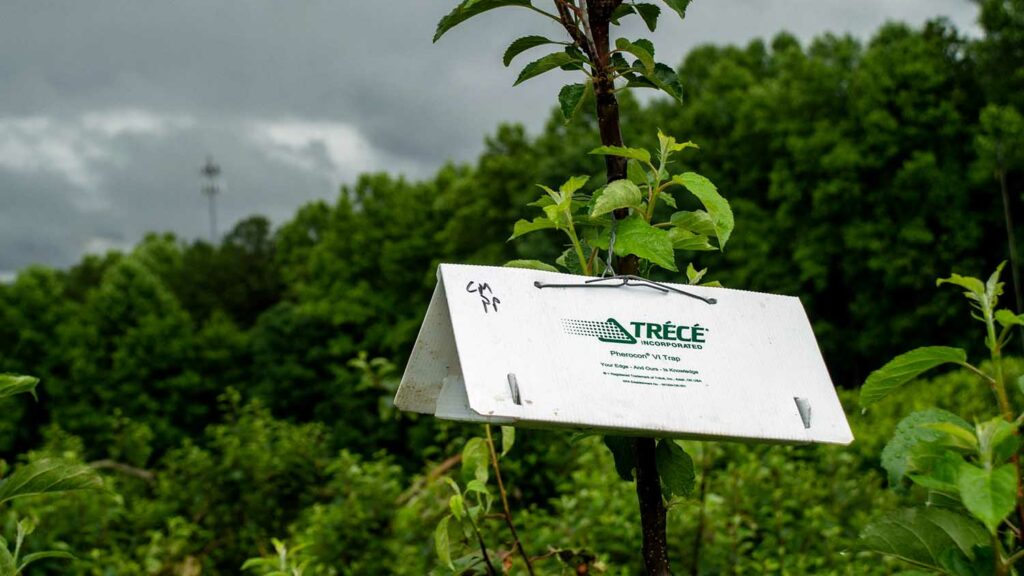
Pheromone traps have proved effective at protecting crops from pests.
Sometimes when there are few alternatives, reviving older approaches to managing insects may be necessary. One example is using reflective mulches to repel insects from the crop, essentially fooling them. Some growers are beginning to use reflective mulches in tomato beds to combat insecticide-resistant western flower thrips.
“You typically grow tomatoes on black or white plastic,” Walgenbach said. “With reflective mulches, when the insect approaches the crop the reflection repels the thrips out of the crop area.”
There are certainly many peaks and valleys in the life of an Extension researcher. Insects adapt, and last year’s success might be this year’s challenge. And researched-based solutions to problems, whether old or new, aren’t immediate.
“That is what is oftentimes what is most frustrating for me,” Walgenbach said. “Growers have a problem, and I don’t have a short-term solution for them.”
Still, his enthusiasm when he talks about research programs is palpable. The solutions might not be immediate, but it sure is exciting when you figure something out.
“Oh gosh yeah,” he said. “That’s what is really enjoyable. You see there’s a problem, and at first really don’t understand it. You study the ecology and biology and see the interactions of different plant species and habitats and biological control agents, and you find an answer.”
Perhaps he’s not so far removed from the young boy who delighted at the crop dusters after all.
“This has been a blast,” he said.

